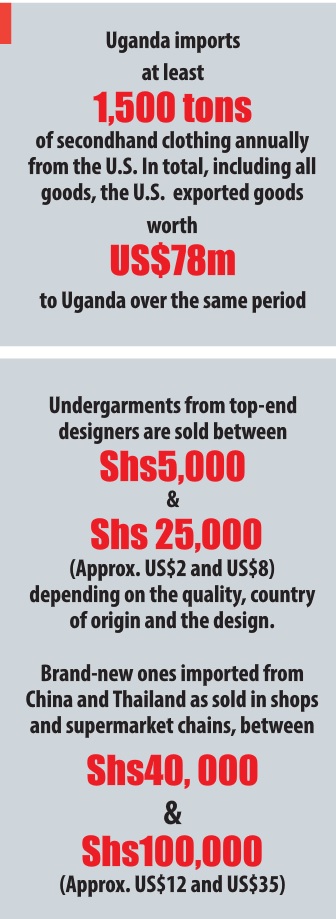Walk into any top corporate office in Uganda, and you can be certain tht 90% of the fashionable people busy at their computer consoles will be wearing something if not everything second-hand.
Most of them buy them in shops around the city that specialize in second-hand items. Most of these shops buy from Owino and resale at a margin.
For those who prefer to buy directly from Owino, it is easy for one to get lost in the excitement and narrow route that leads to an endless array of new sale points of more exciting merchandise in myriad colours.
The market operates seven days a week and numbers are higher on weekends, public holidays, and the festive seasons.
Most of the traders here are women with partial education like Namisango who have no other chances for gainful employment and operate with little capital. The men largely occupy more established stores and import the used items. There are also foreigners, mainly Chinese, Asians, and Arabs, who dominate the import business. These resell to the powerful Uganda men, who resell to the Ugandan small women.
Traders here are not concerned about the U.S. and AGOA. Their immediate worry is over plans by the Kampala Capital City Authority to kick them off their patch and construct a “modern market”. Such markets have been flops in other parts of the city where they have been built because they do not cater for how trade in second-hand markets like Owino is done – as a visit to the market shows.
Here, the traders lay out the merchandise as if on one endless mat. Goods on the bare market floor compete with neighbours on short-metre- high stalls, with or without canopies, and of wooden frames, concrete blocks, or metal. The undergarments seller is next to the shoe seller, who is next to a duvet seller and handbags, belts, skirts, and jeans dealer. Competition is tight and the colours are captivating and the deafening as traders holler for customers and make mad dashes to complete a sale.

Similar but smaller markets are found in other parts of Kampala city; like Nakawa, along the Jinja Highway, about 4Kms from the city centre. This one sits on six acres. Other markets are in suburbs of Nateete, Kibuye and Bwaise and in other towns all over the country. Second-hand items are big business and attract traders from across the East African region like Kevin Otieno Ouma, who we met in Owino.
Otieno Ouma is a dealer in second hand shoes from Kenya. He says he buys items from Owino and sells in various markets in Kenya.
“I do not have a specified shop but move from one open air market to another to sell my products depending on whichever market day. I go to Busia, Funyula, Port and Bumala,” he says.
According to him, used items are cheaper in Uganda and he easily sells them at a profit in Kenya.
“Customers love the products from Kampala because of quality as compared to other competitors who bring from Nairobi,” he says.
He says many times he travels with other traders from Nairobi and other parts of Kenya and Tanzania. They arrive on Friday afternoon and catch the early bust of trading on Saturday morning when new merchandise is unveiled.
Legacy of failed economy
Trade in second-hand items thrived in Uganda following the collapse of the economy in the 1970s when the Uganda textile industry collapsed. People were poor and second-hand goods were not items of trade; they were handed out free by donor agencies.
When attempts were made to redevelop the economy, the World Bank/IMF dictated liberalisation meant that Uganda’s struggling manufactures were exposed to competition from the west. Since Ugandans could not afford new manufactured items, smart traders started dealing in used clothes, shoes, electrical, cars, and even machinery. Soon, even when Ugandans could afford the new items, they developed a preference for the used which they fondly call “original”. Matters were not helped when the imported new items were of lower quality from emerging manufactures like China and were also more expensive. The used items were seen as cheaper and of better quality.
Namisango, for example, sells undergarments from top-end designers like Victoria’s Secrets, AerieREAL, Adore Me, and Thirdlove. Buyers get them at a bargain – between Shs5,000 and Shs 25,000(Approx. US$2 and US$8) depending on the quality, country of origin and the design. These are cheaper than the brand-new ones imported from China and Thailand as sold in shops and supermarket chains, between Shs40, 000 and Shs100,000 (Approx. US$12 and US$35)
The popularity of used items killed off any hope of reviving Uganda’s manufacturing sector.
Now, Uganda wants to fight back. Although a National Textiles Policy mooted in 2009 proposed phasing out secondhand clothes by 2015, it continues to gather dust in parliament without being passed.
But Uganda is not alone. Up to 12 African countries are among 31 worldwide that have banned imports of secondhand clothing, according to a report in The Guardian newspaper of the UK. Ghana for one in 2011 banned the importation and sale of used knickers similar to the ones Namisango sales in Owino due to issues of health hazards.
Uganda is acting under the East African Community plan to ban the importation and trade of second hand clothes by 2019. Meanwhile, according to the plan, the local textile manufacturing needs to be redeveloped to create a boost for local production. Namisango remains unfazed. She says she is determined to keep selling used items.
 The Independent Uganda: You get the Truth we Pay the Price
The Independent Uganda: You get the Truth we Pay the Price


